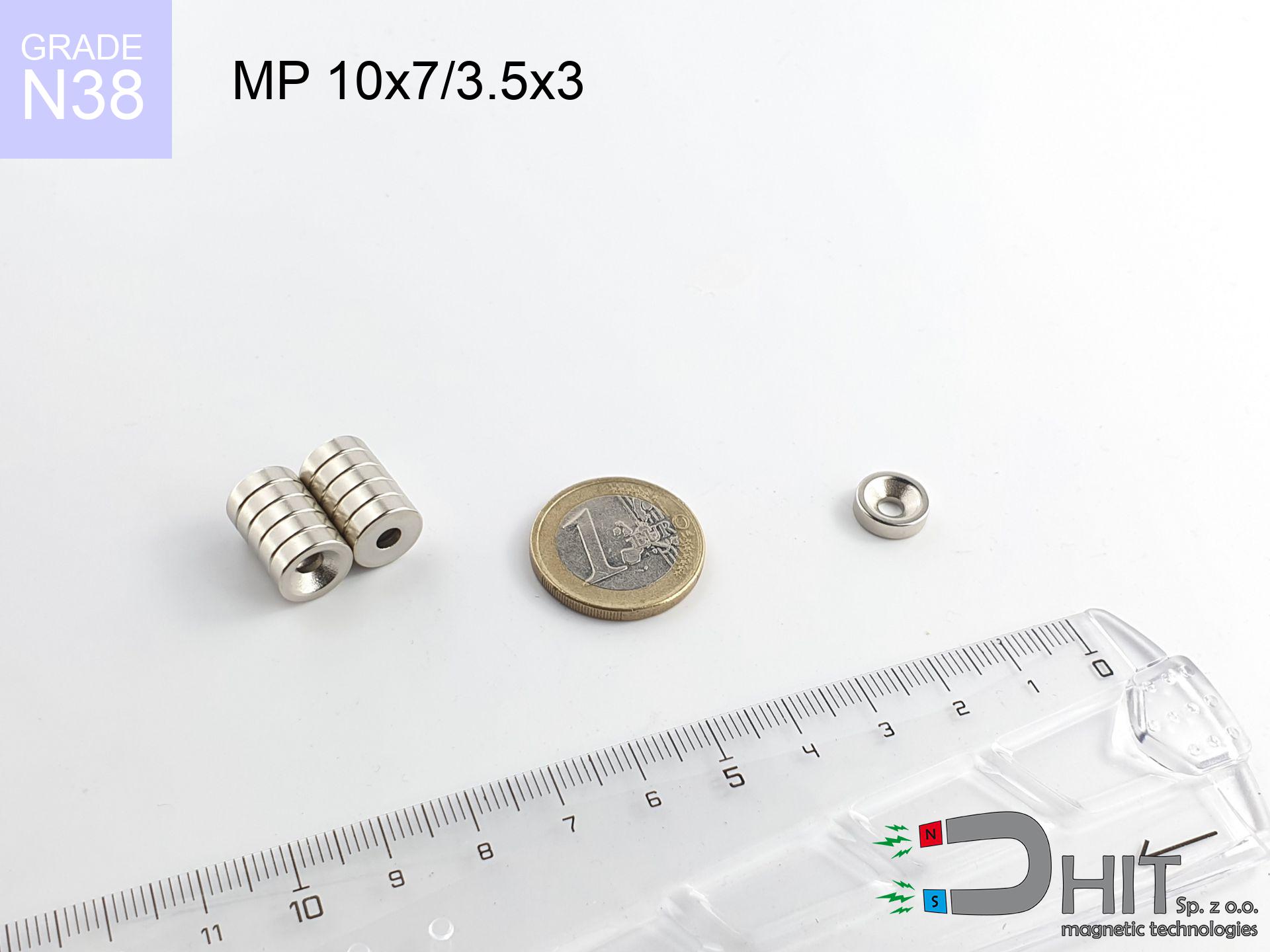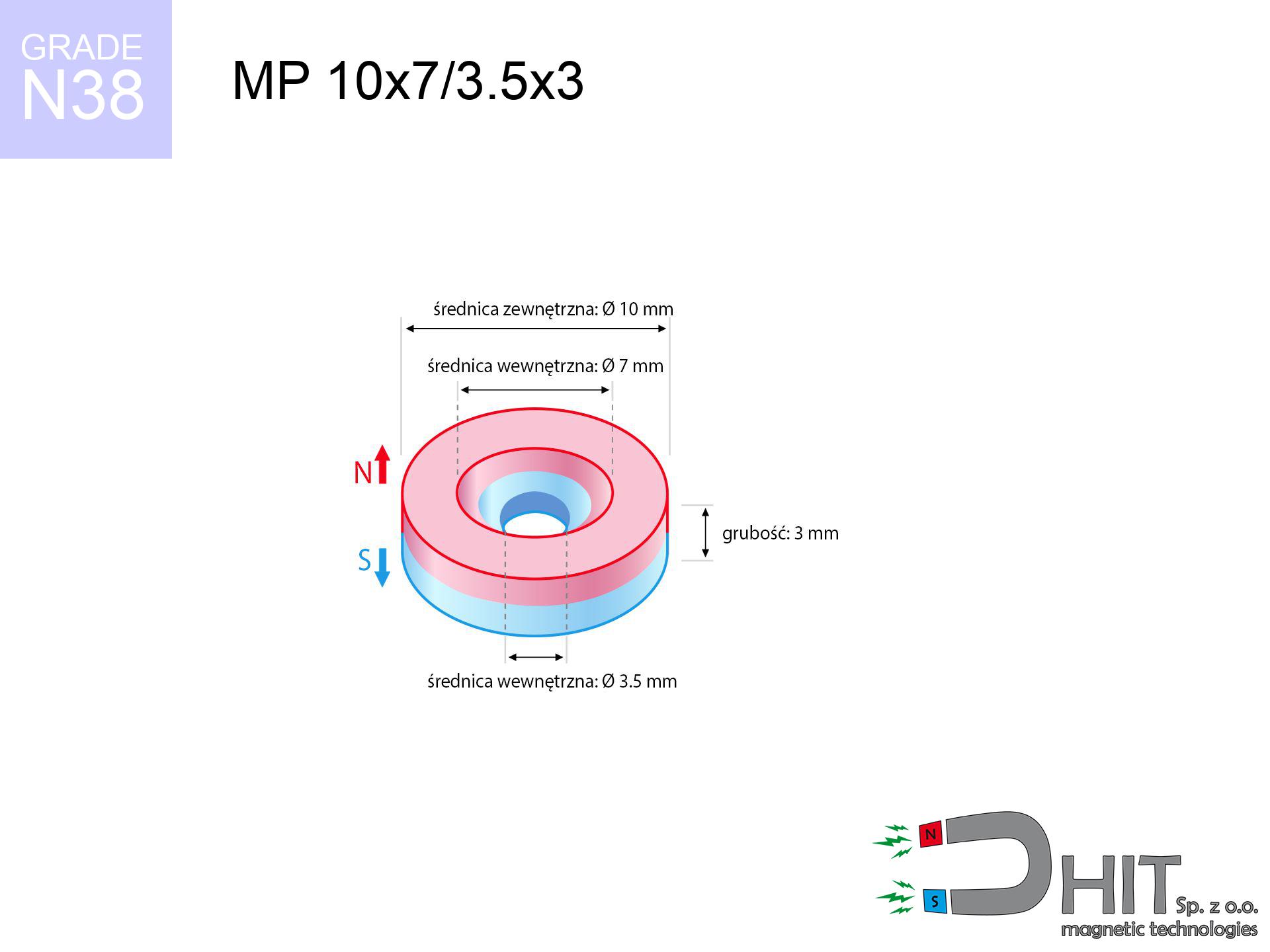MP 10x7/3.5x3 / N38 - ring magnet
ring magnet
Catalog no 030180
GTIN/EAN: 5906301811978
Diameter
10 mm [±0,1 mm]
internal diameter Ø
7/3.5 mm [±0,1 mm]
Height
3 mm [±0,1 mm]
Weight
1.55 g
Magnetization Direction
↑ axial
Load capacity
1.88 kg / 18.47 N
Magnetic Induction
318.70 mT / 3187 Gs
Coating
[NiCuNi] Nickel
0.824 ZŁ with VAT / pcs + price for transport
0.670 ZŁ net + 23% VAT / pcs
bulk discounts:
Need more?
Contact us by phone
+48 888 99 98 98
otherwise send us a note via
contact form
through our site.
Parameters and appearance of neodymium magnets can be reviewed using our
force calculator.
Order by 14:00 and we’ll ship today!
Physical properties - MP 10x7/3.5x3 / N38 - ring magnet
Specification / characteristics - MP 10x7/3.5x3 / N38 - ring magnet
| properties | values |
|---|---|
| Cat. no. | 030180 |
| GTIN/EAN | 5906301811978 |
| Production/Distribution | Dhit sp. z o.o. |
| Country of origin | Poland / China / Germany |
| Customs code | 85059029 |
| Diameter | 10 mm [±0,1 mm] |
| internal diameter Ø | 7/3.5 mm [±0,1 mm] |
| Height | 3 mm [±0,1 mm] |
| Weight | 1.55 g |
| Magnetization Direction | ↑ axial |
| Load capacity ~ ? | 1.88 kg / 18.47 N |
| Magnetic Induction ~ ? | 318.70 mT / 3187 Gs |
| Coating | [NiCuNi] Nickel |
| Manufacturing Tolerance | ±0.1 mm |
Magnetic properties of material N38
| properties | values | units |
|---|---|---|
| remenance Br [min. - max.] ? | 12.2-12.6 | kGs |
| remenance Br [min. - max.] ? | 1220-1260 | mT |
| coercivity bHc ? | 10.8-11.5 | kOe |
| coercivity bHc ? | 860-915 | kA/m |
| actual internal force iHc | ≥ 12 | kOe |
| actual internal force iHc | ≥ 955 | kA/m |
| energy density [min. - max.] ? | 36-38 | BH max MGOe |
| energy density [min. - max.] ? | 287-303 | BH max KJ/m |
| max. temperature ? | ≤ 80 | °C |
Physical properties of sintered neodymium magnets Nd2Fe14B at 20°C
| properties | values | units |
|---|---|---|
| Vickers hardness | ≥550 | Hv |
| Density | ≥7.4 | g/cm3 |
| Curie Temperature TC | 312 - 380 | °C |
| Curie Temperature TF | 593 - 716 | °F |
| Specific resistance | 150 | μΩ⋅cm |
| Bending strength | 250 | MPa |
| Compressive strength | 1000~1100 | MPa |
| Thermal expansion parallel (∥) to orientation (M) | (3-4) x 10-6 | °C-1 |
| Thermal expansion perpendicular (⊥) to orientation (M) | -(1-3) x 10-6 | °C-1 |
| Young's modulus | 1.7 x 104 | kg/mm² |
Technical modeling of the magnet - technical parameters
Presented data constitute the result of a engineering calculation. Values are based on algorithms for the class Nd2Fe14B. Operational parameters might slightly differ from theoretical values. Treat these calculations as a preliminary roadmap during assembly planning.
Table 1: Static pull force (pull vs gap) - interaction chart
MP 10x7/3.5x3 / N38
| Distance (mm) | Induction (Gauss) / mT | Pull Force (kg) | Risk Status |
|---|---|---|---|
| 0 mm |
2813 Gs
281.3 mT
|
1.88 kg / 1880.0 g
18.4 N
|
low risk |
| 1 mm |
2373 Gs
237.3 mT
|
1.34 kg / 1338.1 g
13.1 N
|
low risk |
| 2 mm |
1870 Gs
187.0 mT
|
0.83 kg / 830.9 g
8.2 N
|
low risk |
| 3 mm |
1416 Gs
141.6 mT
|
0.48 kg / 476.6 g
4.7 N
|
low risk |
| 5 mm |
785 Gs
78.5 mT
|
0.15 kg / 146.4 g
1.4 N
|
low risk |
| 10 mm |
214 Gs
21.4 mT
|
0.01 kg / 10.9 g
0.1 N
|
low risk |
| 15 mm |
81 Gs
8.1 mT
|
0.00 kg / 1.6 g
0.0 N
|
low risk |
| 20 mm |
38 Gs
3.8 mT
|
0.00 kg / 0.3 g
0.0 N
|
low risk |
| 30 mm |
12 Gs
1.2 mT
|
0.00 kg / 0.0 g
0.0 N
|
low risk |
| 50 mm |
3 Gs
0.3 mT
|
0.00 kg / 0.0 g
0.0 N
|
low risk |
Table 2: Vertical load (wall)
MP 10x7/3.5x3 / N38
| Distance (mm) | Friction coefficient | Pull Force (kg) |
|---|---|---|
| 0 mm | Stal (~0.2) |
0.38 kg / 376.0 g
3.7 N
|
| 1 mm | Stal (~0.2) |
0.27 kg / 268.0 g
2.6 N
|
| 2 mm | Stal (~0.2) |
0.17 kg / 166.0 g
1.6 N
|
| 3 mm | Stal (~0.2) |
0.10 kg / 96.0 g
0.9 N
|
| 5 mm | Stal (~0.2) |
0.03 kg / 30.0 g
0.3 N
|
| 10 mm | Stal (~0.2) |
0.00 kg / 2.0 g
0.0 N
|
| 15 mm | Stal (~0.2) |
0.00 kg / 0.0 g
0.0 N
|
| 20 mm | Stal (~0.2) |
0.00 kg / 0.0 g
0.0 N
|
| 30 mm | Stal (~0.2) |
0.00 kg / 0.0 g
0.0 N
|
| 50 mm | Stal (~0.2) |
0.00 kg / 0.0 g
0.0 N
|
Table 3: Wall mounting (shearing) - behavior on slippery surfaces
MP 10x7/3.5x3 / N38
| Surface type | Friction coefficient / % Mocy | Max load (kg) |
|---|---|---|
| Raw steel |
µ = 0.3
30% Nominalnej Siły
|
0.56 kg / 564.0 g
5.5 N
|
| Painted steel (standard) |
µ = 0.2
20% Nominalnej Siły
|
0.38 kg / 376.0 g
3.7 N
|
| Oily/slippery steel |
µ = 0.1
10% Nominalnej Siły
|
0.19 kg / 188.0 g
1.8 N
|
| Magnet with anti-slip rubber |
µ = 0.5
50% Nominalnej Siły
|
0.94 kg / 940.0 g
9.2 N
|
Table 4: Steel thickness (substrate influence) - power losses
MP 10x7/3.5x3 / N38
| Steel thickness (mm) | % power | Real pull force (kg) |
|---|---|---|
| 0.5 mm |
|
0.19 kg / 188.0 g
1.8 N
|
| 1 mm |
|
0.47 kg / 470.0 g
4.6 N
|
| 2 mm |
|
0.94 kg / 940.0 g
9.2 N
|
| 5 mm |
|
1.88 kg / 1880.0 g
18.4 N
|
| 10 mm |
|
1.88 kg / 1880.0 g
18.4 N
|
Table 5: Thermal resistance (material behavior) - power drop
MP 10x7/3.5x3 / N38
| Ambient temp. (°C) | Power loss | Remaining pull | Status |
|---|---|---|---|
| 20 °C | 0.0% |
1.88 kg / 1880.0 g
18.4 N
|
OK |
| 40 °C | -2.2% |
1.84 kg / 1838.6 g
18.0 N
|
OK |
| 60 °C | -4.4% |
1.80 kg / 1797.3 g
17.6 N
|
|
| 80 °C | -6.6% |
1.76 kg / 1755.9 g
17.2 N
|
|
| 100 °C | -28.8% |
1.34 kg / 1338.6 g
13.1 N
|
Table 6: Two magnets (repulsion) - forces in the system
MP 10x7/3.5x3 / N38
| Gap (mm) | Attraction (kg) (N-S) | Repulsion (kg) (N-N) |
|---|---|---|
| 0 mm |
2.86 kg / 2858 g
28.0 N
4 419 Gs
|
N/A |
| 1 mm |
2.46 kg / 2464 g
24.2 N
5 224 Gs
|
2.22 kg / 2217 g
21.8 N
~0 Gs
|
| 2 mm |
2.03 kg / 2034 g
20.0 N
4 747 Gs
|
1.83 kg / 1831 g
18.0 N
~0 Gs
|
| 3 mm |
1.62 kg / 1624 g
15.9 N
4 242 Gs
|
1.46 kg / 1462 g
14.3 N
~0 Gs
|
| 5 mm |
0.96 kg / 963 g
9.4 N
3 266 Gs
|
0.87 kg / 867 g
8.5 N
~0 Gs
|
| 10 mm |
0.22 kg / 223 g
2.2 N
1 570 Gs
|
0.20 kg / 200 g
2.0 N
~0 Gs
|
| 20 mm |
0.02 kg / 17 g
0.2 N
429 Gs
|
0.01 kg / 15 g
0.1 N
~0 Gs
|
| 50 mm |
0.00 kg / 0 g
0.0 N
41 Gs
|
0.00 kg / 0 g
0.0 N
~0 Gs
|
Table 7: Safety (HSE) (implants) - precautionary measures
MP 10x7/3.5x3 / N38
| Object / Device | Limit (Gauss) / mT | Safe distance |
|---|---|---|
| Pacemaker | 5 Gs (0.5 mT) | 4.5 cm |
| Hearing aid | 10 Gs (1.0 mT) | 3.5 cm |
| Timepiece | 20 Gs (2.0 mT) | 3.0 cm |
| Phone / Smartphone | 40 Gs (4.0 mT) | 2.0 cm |
| Remote | 50 Gs (5.0 mT) | 2.0 cm |
| Payment card | 400 Gs (40.0 mT) | 1.0 cm |
| HDD hard drive | 600 Gs (60.0 mT) | 1.0 cm |
Table 8: Collisions (kinetic energy) - collision effects
MP 10x7/3.5x3 / N38
| Start from (mm) | Speed (km/h) | Energy (J) | Predicted outcome |
|---|---|---|---|
| 10 mm |
35.25 km/h
(9.79 m/s)
|
0.07 J | |
| 30 mm |
60.84 km/h
(16.90 m/s)
|
0.22 J | |
| 50 mm |
78.54 km/h
(21.82 m/s)
|
0.37 J | |
| 100 mm |
111.07 km/h
(30.85 m/s)
|
0.74 J |
Table 9: Corrosion resistance
MP 10x7/3.5x3 / N38
| Technical parameter | Value / Description |
|---|---|
| Coating type | [NiCuNi] Nickel |
| Layer structure | Nickel - Copper - Nickel |
| Layer thickness | 10-20 µm |
| Salt spray test (SST) ? | 24 h |
| Recommended environment | Indoors only (dry) |
Table 10: Electrical data (Flux)
MP 10x7/3.5x3 / N38
| Parameter | Value | SI Unit / Description |
|---|---|---|
| Magnetic Flux | 1 899 Mx | 19.0 µWb |
| Pc Coefficient | 0.37 | Low (Flat) |
Table 11: Physics of underwater searching
MP 10x7/3.5x3 / N38
| Environment | Effective steel pull | Effect |
|---|---|---|
| Air (land) | 1.88 kg | Standard |
| Water (riverbed) |
2.15 kg
(+0.27 kg Buoyancy gain)
|
+14.5% |
1. Wall mount (shear)
*Warning: On a vertical surface, the magnet retains just approx. 20-30% of its max power.
2. Steel saturation
*Thin steel (e.g. 0.5mm PC case) significantly reduces the holding force.
3. Temperature resistance
*For N38 material, the critical limit is 80°C.
4. Demagnetization curve and operating point (B-H)
chart generated for the permeance coefficient Pc (Permeance Coefficient) = 0.37
The chart above illustrates the magnetic characteristics of the material within the second quadrant of the hysteresis loop. The solid red line represents the demagnetization curve (material potential), while the dashed blue line is the load line based on the magnet's geometry. The Pc (Permeance Coefficient), also known as the load line slope, is a dimensionless value that describes the relationship between the magnet's shape and its magnetic stability. The intersection of these two lines (the black dot) is the operating point — it determines the actual magnetic flux density generated by the magnet in this specific configuration. A higher Pc value means the magnet is more 'slender' (tall relative to its area), resulting in a higher operating point and better resistance to irreversible demagnetization caused by external fields or temperature. A value of 0.42 is relatively low (typical for flat magnets), meaning the operating point is closer to the 'knee' of the curve — caution is advised when operating at temperatures near the maximum limit to avoid strength loss.
Material specification
| iron (Fe) | 64% – 68% |
| neodymium (Nd) | 29% – 32% |
| boron (B) | 1.1% – 1.2% |
| dysprosium (Dy) | 0.5% – 2.0% |
| coating (Ni-Cu-Ni) | < 0.05% |
Ecology and recycling (GPSR)
| recyclability (EoL) | 100% |
| recycled raw materials | ~10% (pre-cons) |
| carbon footprint | low / zredukowany |
| waste code (EWC) | 16 02 16 |
Other offers
Strengths as well as weaknesses of Nd2Fe14B magnets.
Strengths
- They virtually do not lose strength, because even after ten years the decline in efficiency is only ~1% (according to literature),
- Neodymium magnets are highly resistant to demagnetization caused by magnetic disturbances,
- Thanks to the shiny finish, the plating of nickel, gold-plated, or silver-plated gives an elegant appearance,
- Magnetic induction on the working layer of the magnet turns out to be impressive,
- Through (adequate) combination of ingredients, they can achieve high thermal resistance, allowing for functioning at temperatures approaching 230°C and above...
- Possibility of custom creating and modifying to individual conditions,
- Significant place in advanced technology sectors – they serve a role in hard drives, motor assemblies, advanced medical instruments, as well as complex engineering applications.
- Thanks to their power density, small magnets offer high operating force, in miniature format,
Disadvantages
- At strong impacts they can break, therefore we recommend placing them in special holders. A metal housing provides additional protection against damage, as well as increases the magnet's durability.
- We warn that neodymium magnets can lose their power at high temperatures. To prevent this, we advise our specialized [AH] magnets, which work effectively even at 230°C.
- Due to the susceptibility of magnets to corrosion in a humid environment, we advise using waterproof magnets made of rubber, plastic or other material immune to moisture, when using outdoors
- Due to limitations in creating threads and complex forms in magnets, we recommend using casing - magnetic holder.
- Health risk to health – tiny shards of magnets pose a threat, if swallowed, which is particularly important in the context of child safety. Additionally, small elements of these devices are able to disrupt the diagnostic process medical when they are in the body.
- Due to complex production process, their price is higher than average,
Holding force characteristics
Best holding force of the magnet in ideal parameters – what contributes to it?
- on a block made of mild steel, perfectly concentrating the magnetic field
- possessing a thickness of minimum 10 mm to avoid saturation
- with a surface perfectly flat
- with direct contact (without coatings)
- for force acting at a right angle (pull-off, not shear)
- at ambient temperature room level
What influences lifting capacity in practice
- Gap between magnet and steel – even a fraction of a millimeter of separation (caused e.g. by varnish or unevenness) significantly weakens the magnet efficiency, often by half at just 0.5 mm.
- Loading method – declared lifting capacity refers to pulling vertically. When applying parallel force, the magnet holds significantly lower power (often approx. 20-30% of nominal force).
- Plate thickness – insufficiently thick steel does not close the flux, causing part of the power to be lost into the air.
- Material type – ideal substrate is pure iron steel. Stainless steels may attract less.
- Surface condition – smooth surfaces ensure maximum contact, which increases field saturation. Uneven metal weaken the grip.
- Temperature – heating the magnet results in weakening of induction. Check the maximum operating temperature for a given model.
Holding force was tested on the plate surface of 20 mm thickness, when a perpendicular force was applied, in contrast under shearing force the lifting capacity is smaller. Additionally, even a slight gap between the magnet’s surface and the plate lowers the lifting capacity.
Safe handling of neodymium magnets
Warning for heart patients
Individuals with a ICD should keep an large gap from magnets. The magnetic field can disrupt the functioning of the life-saving device.
Metal Allergy
It is widely known that the nickel plating (standard magnet coating) is a strong allergen. If you have an allergy, prevent touching magnets with bare hands and select versions in plastic housing.
Bone fractures
Large magnets can break fingers instantly. Do not put your hand between two strong magnets.
Dust explosion hazard
Fire warning: Neodymium dust is explosive. Avoid machining magnets without safety gear as this may cause fire.
Impact on smartphones
Remember: rare earth magnets generate a field that interferes with precision electronics. Maintain a separation from your mobile, device, and navigation systems.
Conscious usage
Use magnets with awareness. Their huge power can shock even professionals. Stay alert and do not underestimate their power.
No play value
Always store magnets away from children. Risk of swallowing is high, and the consequences of magnets connecting inside the body are tragic.
Thermal limits
Regular neodymium magnets (N-type) lose magnetization when the temperature goes above 80°C. Damage is permanent.
Protective goggles
Watch out for shards. Magnets can fracture upon uncontrolled impact, launching shards into the air. We recommend safety glasses.
Safe distance
Equipment safety: Neodymium magnets can ruin payment cards and delicate electronics (pacemakers, hearing aids, timepieces).









